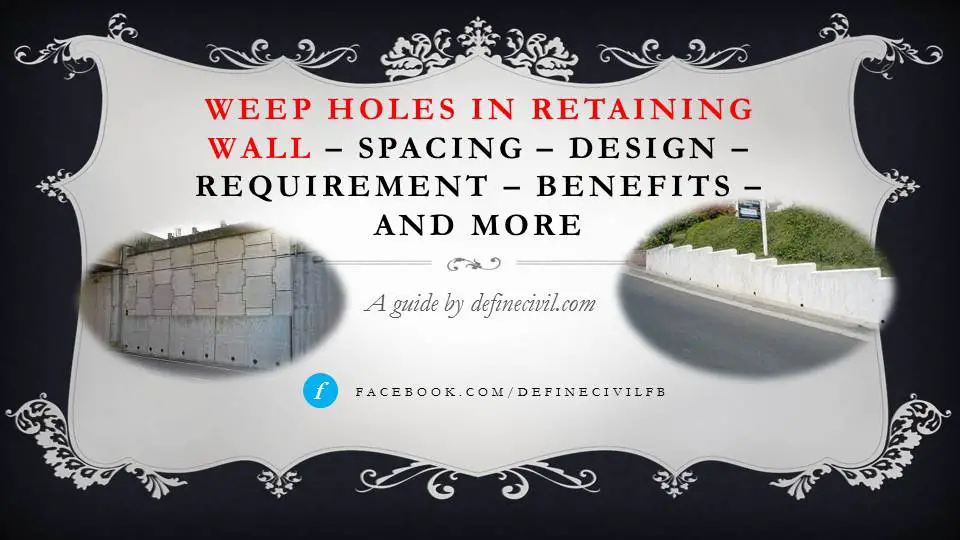A weep hole is simply a vent through the top or center of masonry or retaining wall. The primary purpose of weep holes in retaining walls is to allow drainage through the joints (or between panels) of the wall during wet weather.
The slots also provide a positive indication that the wall is not completely watertight, so they can be used for maintenance purposes or as future access openings if it becomes necessary to dig behind the wall.
There are many different types of weep holes, but they all have one thing in common, which is their drainage point to an outside eave area where gravity will then take over and direct it away from the house.

Definition of Weep holes in retaining walls
Weep holes are small rectangular or circular shaped openings in the retaining wall system to allow rainwater to escape. Weep holes significantly reduces the uplift and hydrostatic pore water pressure. Weep holes increases the strength and life of a retaining wall system.
Designers design the spacing and size of the weep holes, depending on the height of the fill, type of retaining system, frequency of rainfall, and type of soil beneath the structure. In case of concrete retaining walls, we embed PVC pipes in the concrete structure to take shape of a circular opening. In stone masonry walls, we provide gap between two stone layers to act as a weep hole.
What are weep holes?
You’ll find these openings or weep holes in all sort of structures retaining soil mass. We provide weep holes in retaining walls, wing walls, bridges, underpasses, pedestrian trenches, other trenches, or external brick walls. The main purpose of weep holes is to remove hydrostatic pressure from developing behind the wall system.
The size and opening of the holes must be sufficient enough to drain off rainwater through it and avoid structural damage. The height of weep holes must be in accordance with the maximum height of the water accumulation of the groundwater table in that area.
Introduction to weep holes in retaining walls
- Water has a very adverse impact on retaining walls and structures. It drastically increases the load impact from the retaining soil mass.
- The hydrostatic pressure of the retaining soil mass is enormous which should be avoided by all means.
- Engineer does recommend providing proper drainage of the surface water to avoid percolation in the retaining soil mass.
- But still you need to provide small openings in rectangular or circular shape to allow percolating water to drain through the retaining wall.
- We also provide weep holes in the bridge wing walls that retaining the soil mass inside out.
Need of weep holes in retaining walls
Here are 5 reasons why you need weep holes in your retaining wall system, the threats that retaining walls pose, and solutions to them:
1. Weep Holes Allow Water to Drain Away From the Wall
Weep holes–or “inlet openings” as they’re officially known–allow water to drain away from the retaining wall so that it doesn’t leak into your home’s foundation.
If water pools around the base, you could have problems with mold and mildew growing in dark areas where there is no air circulation. The moisture also collects leaves and other garden debris, which will rot if exposed to too much water. These issues can cause structural damage as well as health concerns for anyone living inside your home or close by.
2. Weep Holes Prevent Water from Pooling Around Your Base
While weep holes in concrete retaining walls keep excessive water from building up near your retaining wall, they are also designed to prevent puddles of standing water from forming in the surrounding area.
Not only will water stand around your base make it more susceptible to erosion, but this standing water can also lead to mosquitoes breeding in damp areas where there is no air circulation. Mosquitoes are known for their ability to carry diseases and parasites, so you want to prevent them from multiplying near your home by eliminating standing water.
3. Weep Holes Work in Conjunction with a Sump Pump
One major problem with retaining walls is that they do not withstand high amounts of pressure, which means they are vulnerable to collapse if too much weight is put on them or if saturated soil shifts under their foundation.
For this reason, most walls come with a sump pump–using a silt fence and trench drain systems–that handle the extra weight and water. With this in place, a sump pump provides an outlet for the excess water that has built up around your retaining wall’s base so it can flow out of your home’s foundation and into a nearby rain gutter or drainage system.
4. Weep Holes Can Be Used As an Air Louver for Your Retaining Wall System
When used in conjunction with a sump pump, weep holes in brick retaining walls can be used as air louvers to provide insulation from extreme temperatures for your retaining wall system.
Depending on how many holes you decide to have installed, these small spaces could either push warm air away from the interior of your house or keep cold breezes from blowing on your wall. Most homeowners choose to insulate their walls during the winter months when they do not want their walls to be affected by snow, which can cause them to freeze and crack if temperatures drop too low.
5. Weep Holes Can Be Used For Drainage When Installing a Retaining Wall System
Weep holes–and sump pumps in general–are usually used for drainage purposes only, but some landscape architects have come up with a few clever solutions that put weep holes to work as an additional design element on your retaining wall system.
By spacing small holes evenly all over the surface of each horizontal block or stone that makes up your wall, you could effectively turn it into a mister system so that you don’t have to spray your plants with water manually. This could also be used in other creative ways. For example, additional holes could be formed into the bottom of stone blocks that are placed over dirt paths so you can easily clean up after pets, or an array of holes could even be implemented around top-heavy features such as a tree rock or birdbath for drainage purposes.
Location of the weep holes
So, where should be the weep holes provided? Well, we know by the law of gravity that water flows and percolates down to the toe of the soil mass. Therefore, designers provide weep holes at the lowest point or bottom of the retaining wall.
Sometimes, we provide weep holes in the brick masonry walls for ventilation to allow air to the back of the wall.

Types of weep holes in retaining walls
Following are the common types of weep holes in retaining walls depending on the nature of use:
1. Open Head Joint Weep Holes
Open head joint weep holes are those we provide above the window or near the foundation. As the name suggests, we provide one open joint of the same size as joint of a brick in a wall. This opening serves as the weep hole. It is best if you’re fighting off the water seepage in the wall issues.
2. Cotton Rope Wicking Weep Holes
In this type, we provide a rope of 12 inches in length that act as a weep hole. We just place this in the joints that extend to the cavity wall. The water from the back of the wall is absorbed by the cotton and on the other side, it gets evaporated.
3. Tubes weep holes
Tube weep holes are formed with the help of hollow plastic or metal tubes which are spaced around 16 inches from each other. The Tube weep holes are installed at a slight angle to allow water to drip out easily and care should be taken that the angle should not be too steep.
Sometimes a Shallow layer of gravel is laid to prevent the water from dropping from the blockage of the tube weep holes.
4. Corrugated channels as weep holes
Corrugated channels are the latest technology in the weep holes which helps to quickly drain off water from the multiple channels. It is installed at the bottom side of the bed joint of the mortar.
Disadvantages of weep holes
Weep holes without a doubt play a significant role in long life of retaining walls. Yet, they might not be the ideal structures owing to the disadvantages that comes aside:
- Weep holes tend to get blocked by trash or mortar in brick masonry walls. The debris overtime will be collected inside the holes, avoiding the easy passage of water.
- In case of weep holes in foundation or brick masonry walls of a building, the pests or rodents can make their houses insides. You need to provide baffled vent in such a case to avoid ingress of rodents or insects.
- In case you’re using weep holes for the flow of air, such vent covers would cause obstruction in air flow.
Bottom Line – Do we need to provide weep holes in retaining walls?
Retaining walls are important for providing a foundation and preventing erosion, but they also can drain water away from your home. Weep holes allow you to install sump pumps without worrying about having standing water around your retaining wall system–plus these small spaces can be used as air louvers or even space for drainage purposes in creative ways. If you’re thinking of installing a new retaining wall near your property, ensure that it has weep holes installed! Weep now or weep later!


















